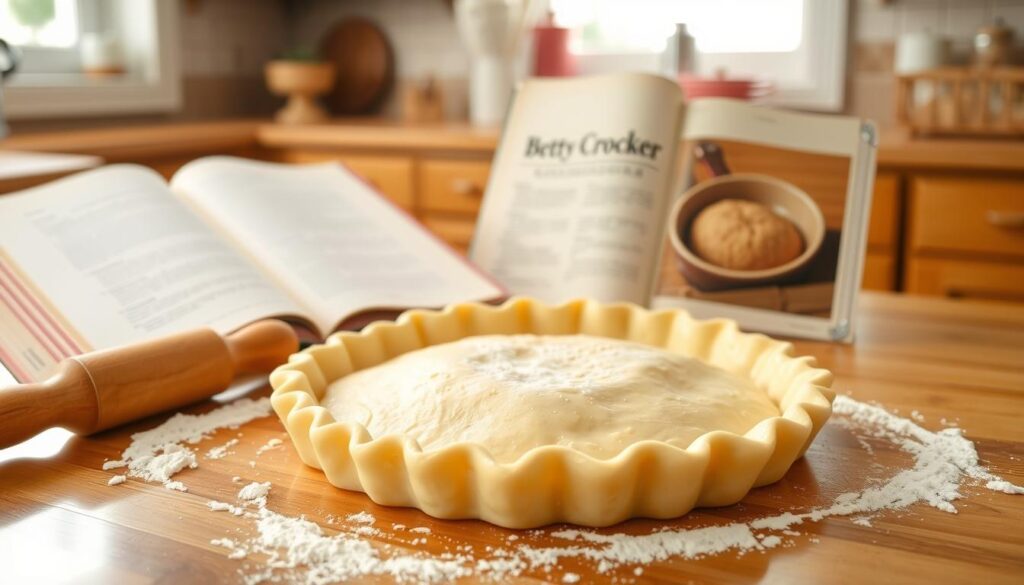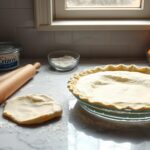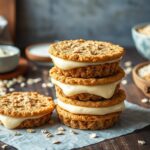Master the art of pie crust with this straightforward Betty Crocker pie crust recipe. Create a delicious, homemade crust in no time.
Table of Contents
They offer a simple and delicious solution for homemade pie crust, with the betty crocker pie crust recipe being a popular choice among bakers. This easy recipe provides a perfect foundation for a variety of sweet and savory fillings, making it a staple in many kitchens. With the right ingredients and techniques, anyone can master the art of making a homemade pie crust.
Making a homemade pie crust can seem intimidating, but with a tried-and-true recipe like betty crocker’s, it can be a breeze. This easy recipe is perfect for beginners and experienced bakers alike, providing a flaky and delicious crust that is sure to impress. By following a simple betty crocker pie crust recipe, anyone can create a delicious homemade pie crust that is perfect for any occasion, using an easy recipe to make the process enjoyable and stress-free.
The Legacy of Betty Crocker’s Pie Crust
Betty Crocker’s pie crust recipe has been a staple in many American households for generations. The recipe’s enduring popularity can be attributed to its simplicity and the use of high-quality ingredients. Baking a pie crust from scratch can be a daunting task, but with Betty Crocker’s guidance, home cooks can achieve a flaky and delicious crust with ease.
The history of Betty Crocker pie crust recipe famous recipe dates back to the early 20th century. The company’s commitment to providing reliable and trustworthy recipes has made it a household name. When it comes to baking a pie crust, many people turn to Betty Crocker’s tried-and-true recipe. The pie crust recipe is a classic, and its popularity endures due to its ease of use and consistent results.
History of Betty Crocker’s Famous Recipe
Betty Crocker pie crust recipe has undergone several revisions over the years, but its core principles remain the same. The recipe’s success lies in its use of simple ingredients and a straightforward mixing process. Baking enthusiasts appreciate the recipe’s versatility, as it can be used to make a variety of sweet and savory pies.
Why This Recipe Stands the Test of Time
The key to Betty Crocker’s pie crust recipe success lies in its ability to balance simplicity with quality. The recipe’s use of basic ingredients, such as flour and butter, makes it accessible to home cooks of all skill levels. As a result, baking a pie crust from scratch has become a beloved tradition for many families.
Key Features of the Classic Recipe
Some of the key features of Betty Crocker’s pie crust recipe include its use of cold ingredients, gentle mixing, and a careful rolling process. By following these simple steps, home cooks can achieve a flaky and delicious crust that is sure to impress. Whether you’re a seasoned baker or just starting out, Betty Crocker’s pie crust recipe is a must-try.
Essential Ingredients for Betty Crocker Pie Crust Recipe
To make a delicious and flaky pie crust, it’s crucial to use the right pie crust ingredients. The basic components of a classic Betty Crocker pie crust recipe include flour, butter, and water. These baking essentials are the foundation of a great pastry. When choosing your ingredients, consider the quality and freshness of each item, as this will impact the final result.
A good pastry starts with the right type of flour. All-purpose flour is a popular choice for pie crusts, as it provides a balanced texture and flavor. Cold butter is also essential, as it helps to create a flaky and tender crust. Water should be used sparingly, as too much can lead to a tough or soggy crust.
Here are some key ingredients to keep in mind:
- 2 1/4 cups all-purpose flour
- 1 teaspoon salt
- 1/2 cup cold butter, cut into small pieces
- 1/4 cup ice-cold water
By using these essential ingredients and following a few simple tips, you’ll be well on your way to creating a delicious and flaky pie crust. Remember to keep your ingredients cold, as this will help to create a tender and flaky texture. With the right pie crust ingredients and a bit of practice, you’ll be a pro at making pastry in no time.
Required Kitchen Tools and Equipment
To make a perfect pie crust, it’s essential to have the right kitchen tools and equipment. Having a well-stocked kitchen with basic tools like a mixing bowl, rolling pin, and measuring tools can make a significant difference in the final result. These kitchen tools are designed to help with tasks such as mixing, rolling, and shaping the dough.
In addition to basic tools, there are also optional equipment for advanced techniques, such as a pastry blender or food processor. These baking equipment can help to simplify the process and achieve a more consistent texture. Measuring tools, such as a digital scale or measuring cups, are also crucial for accurate measurements, which can affect the final texture and flavor of the pie crust.
Some of the essential kitchen tools and equipment for making a pie crust include:
- Mixing bowl
- Rolling pin
- Measuring cups and spoons
- Digital scale
- Pastry blender (optional)
- Food processor (optional)
These tools can help to ensure that the dough is mixed, rolled, and shaped correctly, resulting in a delicious and flaky pie crust. By investing in the right kitchen tools and equipment, you can take your baking to the next level and create perfect pie crusts every time.
| Tool | Description |
|---|---|
| Mixing Bowl | A large bowl used for mixing ingredients |
| Rolling Pin | A tool used for rolling out the dough |
| Measuring Cups and Spoons | Used for accurate measurements of ingredients |
Step-by-Step Mixing Instructions
To achieve a smooth and even dough, it’s essential to follow the pie crust mixing instructions carefully. Start by combining the dry ingredients, such as flour and salt, in a large bowl. Next, cut in the butter using a pastry blender or your fingers until the mixture resembles coarse crumbs.
Gradually add the water, stirring the mixture with a fork until it forms a shaggy dough. Be careful not to overmix, as this can lead to a tough crust. The goal is to create a dough that is just combined and still slightly crumbly.
Here are the key steps to follow for baking instructions:
- Combine dry ingredients in a large bowl
- Cut in the butter until the mixture resembles coarse crumbs
- Gradually add the water, stirring with a fork until the dough comes together
By following these easy recipe steps, you’ll be able to create a well-mixed dough that’s ready to be rolled out and baked into a delicious pie crust.
Rolling and Shaping Techniques
To achieve a beautifully presented pie, it’s essential to master the techniques of pie crust rolling and shaping. This process involves using the right amount of pressure to roll out the dough evenly, ensuring a uniform thickness throughout. By doing so, the crust will bake consistently, preventing undercooked or overcooked areas.
When it comes to pie crust rolling, it’s crucial to use a gentle touch to avoid stretching or tearing the dough. This can be achieved by using a rolling pin with a smooth surface, allowing for effortless gliding and even pressure distribution. As for shaping techniques, the goal is to create a crust that fits perfectly into the pie pan, with a decorative edge that adds a touch of elegance to the finished pie.
Proper Rolling Methods
Proper rolling methods involve starting from the center of the dough and working your way outwards, using long, smooth strokes to maintain evenness. This helps prevent the formation of air pockets and ensures the crust will hold its shape during baking.
Transferring to the Pie Pan
Once the crust is rolled out to the desired thickness, it’s time to transfer it to the pie pan. This can be done by gently lifting the edges of the crust and sliding it into the pan, making sure to press it firmly into the corners and edges.
Creating Decorative Edges
Creating decorative edges is the final step in shaping the pie crust. This can be achieved by using a fork to crimp the edges or by creating a braided pattern using excess dough. The result is a beautifully presented pie with a crust that’s both delicious and visually appealing.
By mastering these pie crust rolling and shaping techniques, you’ll be able to create a stunning pie that’s sure to impress your friends and family. With practice, you’ll become more confident in your ability to create a beautifully presented pie, complete with decorative edges and a delicious, flaky crust.
| Technique | Description |
|---|---|
| Pie Crust Rolling | Rolling out the dough to a uniform thickness |
| Shaping Techniques | Creating a crust that fits perfectly into the pie pan |
| Decorative Edges | Adding a touch of elegance to the finished pie |
Common Mistakes and Troubleshooting Tips
When making a pie crust, it’s easy to encounter common mistakes that can affect the final result. Pie crust mistakes can be frustrating, but with the right troubleshooting tips, you can overcome them and achieve a delicious, flaky crust. One of the most common mistakes is overworking the dough, which can lead to a tough, dense crust.
To avoid this, it’s essential to follow the recipe carefully and not overmix the ingredients. Another common mistake is using the wrong type of flour, which can affect the texture and flavor of the crust. By using the right type of flour and following the recipe, you can create a delicious, flaky crust that’s perfect for your favorite pie filling.
Some common pie crust mistakes and their solutions include:
- Overworking the dough: stop mixing as soon as the ingredients come together
- Using the wrong type of flour: use a high-quality, all-purpose flour for the best results
- Not chilling the dough: chill the dough for at least 30 minutes to allow the gluten to relax
By following these troubleshooting tips and being aware of common pie crust mistakes, you can create a delicious, flaky crust that’s perfect for your favorite pie filling. With a little practice and patience, you can become a master pie crust maker and enjoy the perfect baking solutions for your next dessert.
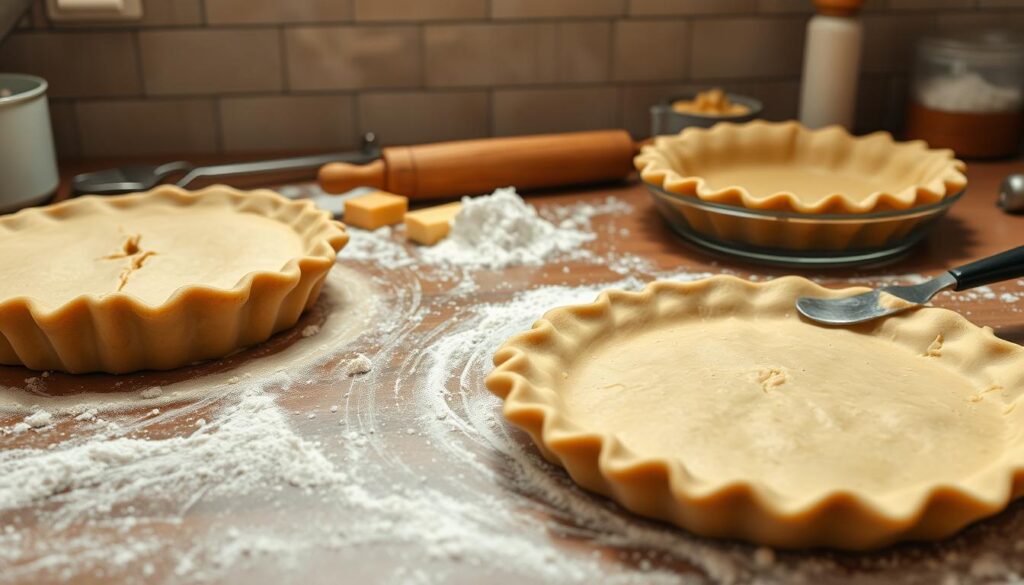
Recipe Variations and Adaptations
When it comes to pie crust variations, the possibilities are endless. One popular option is a gluten-free recipe, which can be made by substituting traditional flour with gluten-free alternatives. This adaptation is perfect for those with dietary restrictions, allowing them to enjoy a delicious homemade pie without worrying about gluten intake.
Another way to modify the classic recipe is by adding sweet or savory ingredients to the crust. For example, a pinch of sugar can enhance the flavor of a fruit pie, while herbs like thyme or rosemary can complement a savory filling. These modifications can be made to suit individual tastes, making the recipe more versatile and exciting.
In addition to these variations, make-ahead options are also available. The pie crust can be prepared in advance and stored in the refrigerator or freezer, making it a convenient option for busy bakers. This feature is especially useful during holidays or special occasions when multiple pies need to be made.
- Gluten-free recipe: made with gluten-free flours like almond or coconut flour
- Sweet pie crust: adds sugar or honey to the crust for a sweet flavor
- Savory pie crust: adds herbs or spices to the crust for a savory flavor
- Make-ahead pie crust: can be prepared in advance and stored in the refrigerator or freezer
By exploring these pie crust variations and adaptations, bakers can create unique and delicious pies that cater to their individual needs and preferences. Whether it’s a gluten-free recipe, sweet or savory modification, or make-ahead option, the possibilities are endless, and the result is always a delicious homemade pie.
| Pie Crust Variation | Description |
|---|---|
| Gluten-free recipe | Made with gluten-free flours like almond or coconut flour |
| Sweet pie crust | Adds sugar or honey to the crust for a sweet flavor |
| Savory pie crust | Adds herbs or spices to the crust for a savory flavor |
| Make-ahead pie crust | Can be prepared in advance and stored in the refrigerator or freezer |
Expert Tips for the Perfect Flaky Texture
To achieve a perfect flaky texture in a pie crust, it’s essential to follow some expert pie crust tips. One of the most critical factors is to keep the ingredients cold, as this will help to create a layered, flaky structure. Using the right type of flour and fat, such as butter or lard, is also crucial for achieving the perfect texture.
Developing baking expertise takes time and practice, but with the right techniques and ingredients, anyone can create a delicious, flaky pie crust. Here are some tips to help you get started:
- Use a combination of all-purpose and pastry flour for a tender, flaky crust
- Keep the butter and water cold to prevent the dough from becoming too warm and sticky
- Use a light touch when rolling out the dough to avoid developing the gluten
By following these expert pie crust tips and practicing your baking expertise, you’ll be able to create a perfect, flaky texture in your pie crust every time. Remember to stay patient and don’t be afraid to experiment with different ingredients and techniques until you find what works best for you.
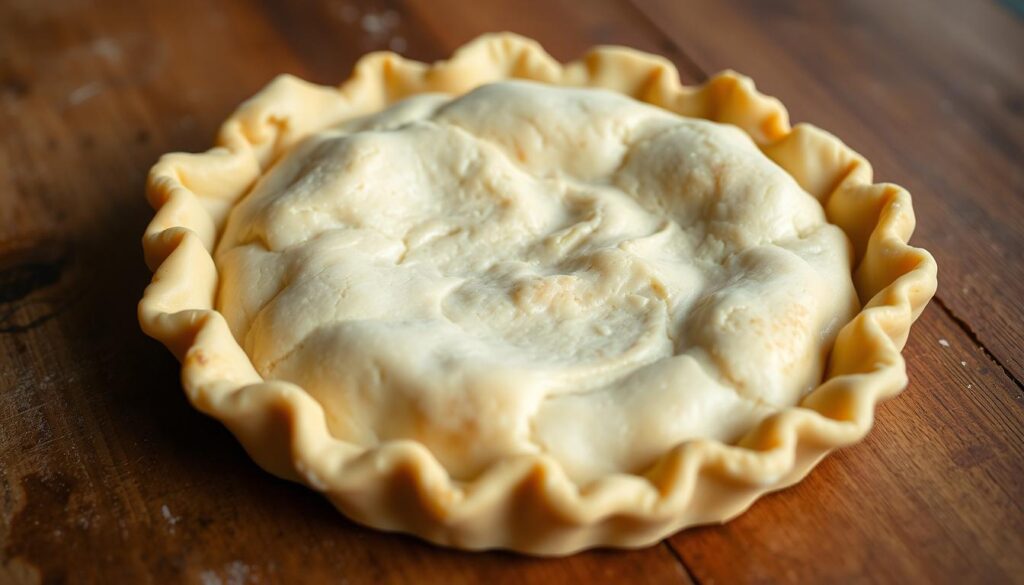
Achieving the perfect flaky texture in a pie crust is a matter of using the right ingredients, following the right techniques, and practicing your baking skills.
| Tips for Achieving a Flaky Texture | Benefits |
|---|---|
| Keep ingredients cold | Helps to create a layered, flaky structure |
| Use the right type of flour and fat | Essential for achieving the perfect texture |
| Develop baking expertise | Helps to create a delicious, flaky pie crust |
Conclusion: Mastering Your Homemade Pie Crust Journey
As you’ve discovered through this comprehensive guide, mastering the art of the homemade pie crust is a rewarding baking journey. The timeless Betty Crocker recipe has stood the test of time, providing a solid foundation for creating flaky, delicious crusts that will impress your family and friends. With the right techniques and a little practice, you’ll be on your way to becoming a pie crust connoisseur.
Remember, baking is an ongoing learning process, and every batch you create will teach you something new. Embrace the challenges, celebrate your successes, and never be afraid to experiment with recipe variations to find your perfect pie crust signature. The satisfaction of serving a homemade pie with a beautifully crafted crust is unparalleled.
Keep this guide close at hand, and don’t hesitate to refer back to it whenever you need a refresher on essential techniques or troubleshooting tips. With each pie you bake, your mastery of the craft will grow, and you’ll take great pride in the delicious results.
Happy baking, and may your pie crust journey be as fulfilling as the treats you create!

